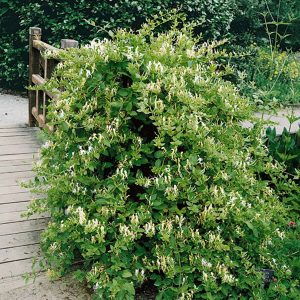Description
Rosa ‘Compassion’ is a beautifully fragrant climbing rose that produces large, semi-double flowers in a delicate shade of salmon pink with golden stamens in the center. The blooms are borne in large clusters and have a subtle spicy fragrance that is sure to delight the senses. This hardy and disease-resistant rose is perfect for growing on trellises, walls, and fences, or even trained as a small climber. The glossy, dark green foliage provides an attractive backdrop to the beautiful blooms. For the best results, plant ‘Compassion’ in a sunny spot with well-draining soil. Some great companion plants for this rose include lavender, catmint, and salvia.
Key Facts
- Common Name(s):Compassion Rose
- Hardiness:Fully hardy
- How big will I get? Rosa ‘Compassion’ can grow to a height of 5m and a spread of 5m.
- Did You Know That:There are over 100 different species of roses, and thousands of hybrids?
Plant Calendar
A rough guide to how this plant will change through the year.
| Jan | Feb | Mar | Apr | May | June | July | Aug | Sept | Oct | Nov | Dec | |
| Flowering Time |   |
  |
  |
|||||||||
| Foliage Colour |  |
 |
 |
 |
 |
 |
 |
 |
 |
| J | F | M | A | M | J | J | A | S | O | N | D |
  |
  |
  |
|||||||||
 |
 |
 |
 |
 |
 |
 |
 |
 |
Care Guide

Soil Requirements
Rosa ‘Compassion’ prefers moist but well-draining soil. This plant can grow in soil with a wide range of pH levels, it is not picky about the pH level of the soil.

Best Position
Rosa ‘Compassion’ can handle either an exposed or a sheltered position and requires full sun to thrive, this consists of more than six hours of direct sunshine per day.

Maintenance
Rosa ‘Compassion’ should be pruned in late winter or early spring, before new growth begins. Start by removing any dead, damaged, or diseased wood from the plant, cutting back to healthy wood and sterilizing your pruning shears between cuts to prevent disease spread. To encourage the growth of new canes, cut back the lateral branches on the main stems to two or three buds. Tie in new canes to your support structure as they grow, using a soft material like twine or velcro tape to prevent damage to the plant. Finally, remove any crossing branches or branches that are rubbing against each other to prevent damage and encourage healthy growth. By following these steps, you can keep your climbing roses healthy, attractive, and blooming beautifully year after year.

Pest, Diseases and Wildlife
Rosa ‘Compassion’ can have problems with aphids, leafhoppers, and scale insects , it can be vulnerable to certain diseases such as black spot, rust and powdery mildews. It is also known to attract bees, butterflies and other pollinators. It is not considered to be toxic.





